Internationally renowned charity Project Seagrass is marking it’s tenth anniversary by re-launching its citizen science website and mobile app SeagrassSpotter which enables anyone and everyone to engage with the seagrass meadows on their doorstep or anywhere else in the world, whether it’s there now or it once was.
SeagrassSpotter was established in 2016 and allows people to upload point data showing the presence of seagrass with photo evidence. Since its initial launch, it has gathered over 7,000 sightings of seagrass from over 3,500 users across 105 countries and has recorded 45 species of seagrass. It’s relaunch will include new features, such as being able to record absence data to track where seagrass may have once existed but is now lost.

Dr Leanne Cullen-Unsworth, CEO at Project Seagrass, said:
“Over the last ten years, we have successfully raised awareness of the importance of seagrass and the role it plays in tackling the biodiversity and climate crises. Now we must accelerate efforts to protect and restore this vital habitat. Everyone can have a part to play in securing a future for seagrass and SeagrassSpotter is a great tool to engage and connect people in seagrass science and mapping all over the world.”
The UK alone has lost up to 92% of its seagrass meadows, an essential ecosystem that protects our coasts, supports the fishing industry, and puts food on our tables.
To monitor, identify and stop the loss of seagrass all over the world, Project Seagrass is calling for more people to engage in citizen science and not only record where seagrass meadows can be seen, but where they once were and now no longer are.
Saving the world’s seagrass meadows is an essential task if we are to address both the climate and biodiversity crises, but making waves to do this requires the many, rather than the few.
Seagrass has long been the unknown and forgotten oceanic plant, a plant that was once terrestrial, and is now becoming a household name as we learn more about its significance to both people and planet.

For instance, seagrass supports 20% of the world’s largest commercial fisheries, therefore without it, our fish stocks will continue to drastically reduce. There are also communities all over the world who are dependent on seagrass, as their main food source, fish, derives from their local seagrass meadows.
When considering nature-based solutions, seagrass meadows are high on the agenda and a hot topic for carbon sequestration and biodiversity support, however, the science required to evidence the quantities is not yet complete. We therefore have much to do in the next decade to ensure we protect the seagrass we have and put back what we have lost.
To achieve this, we must all play our part, which is why citizen science is on the rise. With more people actively engaging in local projects, now is the perfect opportunity for Project Seagrass to re-launch their citizen science web platform and phone app, SeagrassSpotter.
To explore the SeagrassSpotter tool visit https://seagrassspotter.org/

